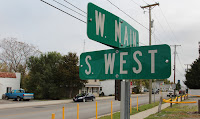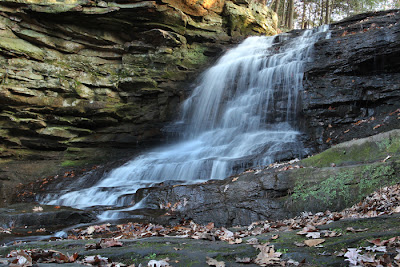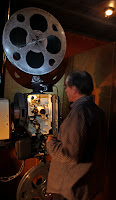We found the above historical marker as we approached downtown Upper Sandusky from the east on the Lincoln Highway--today known as Wyandot Ave. Note the pink area of road surface to the left. That is some of the rarely found, original brick surface of the Lincoln Highway. Some crumbling asphalt road surface of the old highway is visible in the lower photo alongside what is now County Highway 330, 5.3 miles west of downtown Upper Sandusky.
TRAVELING ACROSS OHIO--
On the Lincoln Highway; part 2
We launched this half of our trip across Ohio on the Lincoln Highway (LH) from downtown Mansfield and headed west on Park Ave.
The original Proclamation Route of 1913 took the LH from Mansfield to Galion, Marion, Kenton and on to Lima. We know that today as SR 309. Earlier it became known as US 30-South. But, just three weeks after that route was established the route was changed and, after Galion, went to Bucyrus and on west through Upper Sandusky.
In 1920 a new road from Mansfield to Bucyrus left town via 4th Street. It became known as US 30-N and went through Crestline. For a short while that route branched through Leesville then rejoined route 30 on the way to Bucyrus.
Today, at the corner of Park Ave., West and Western Ave., you will see a sign directing the LH north on Western Ave. That is where the 1920 alignment changed and coursed via 4th St., through Crestline, Bucyrus, Oceola and on to Upper Sandusky on its way west.
There were a few other routing curiosities in this segment. An earlier version of route 30 followed what we now know as Mabee Rd., for a short while. From my childhood recollection that could have been caused by localized, swampy areas that were easier to go around.
A similar event happens west of the new four-lane interchange where route 30 used to follow segments of Eckstein and Snodgrass Rds., for a half mile or so.
That was our route of travel avoiding, of course, the new four-lane US 30 which now extends from Mansfield to Indiana.
After the new four lane highway captures route 30 traffic west of State Route 314 it gets quiet. Very quiet.
We were able to stop in Crestline and ponder LH signs without the snarl of diesel powered traffic.
We did the Leesville detour and didn't even have to signal our turn to other traffic. There wasn't any.

This entire route is dotted with LH signs like the one pictured on the viaducts just after the golf course as we approached downtown Bucyrus.
We trundled along a leisurely 16 miles from Bucyrus until we encountered the historical plaque in the lead photo above on the east side of Upper Sandusky.
As we enjoyed our solitude I was reminded we were experiencing a highway that was the first paved one across the US. This road's history began in 1913. The 1920 route change mentioned above happened just 20 years before I was born.
Thirty six gentle miles later we had crossed I-75 and were in the village of Beaverdam. Here the coast-to-coast LH intersected the north/south, transcontinental road known as the Dixie Highway which traveled from Michigan's Upper Peninsula to Key West.

Just imagine, those two major, US highways crisscrossed on the tiny street in the tiny town pictured behind the road sign of Main and West Streets.
There was not a lot of traffic fuss in those days when there were more horse hitching posts than parking meters on the town's main street.
Ten miles west of Beaver Dam we crossed Pike Run creek and paused briefly to note the site that snarled Admiral Byrd's "Snow Cruiser." which was on its way to an Antarctic expedition in 1939. News accounts of the day said the cruiser hit a bridge and stumbled into the creek causing several days of delay until it could be hoisted out and continue its journey.
Just a few miles west of the accident site our notes indicated we would encounter the "Beach ridge" of the Maumee Glacial Lake which would parallel the LH route nearly 50 miles into Indiana.
The Wisconsin Glacier of the ice age of 14,000 years ago stopped in this area and, while melting, dumped its debris into things geologists call moraines; ridges that later became the routes of trails then highways in modern history.
In the incredibly flat topography of western Ohio this "ridge" was barely discernible.
As we approached Delphos we passed the old junction point of US 30-N and US 30-S where US 30 became whole again.
Thirteen miles northwest of Delphos we enjoyed a visit to Balyeat's Coffee Shop in Van Wert (left) where a patron caused Sue to chuckle as he hustled to avoid our photography. He was a retired fellow, working part time for the local florist and heading to Balyeat's for lunch as folks have done here since the restaurant opened in 1924.
About nine miles west of Van Wert the old road disappears under the new four-lane US 30 which roars on another 6 miles to the Indiana line.
Here, the modern highway has obliterated one of the original "Seedling Miles". These miles scattered along the LH route through Ohio were then very modern concrete slabs meant to inspire further highway improvement after locals experienced the contrast between driving on the original then newly paved portions.
Also in the area from Van Wert to Indiana it looks like a continuous orchard of electricity-producing wind turbines. Strangely restricted to the north side of US 30, these huge white pillars, each topped with an enormous, three-bladed propeller, turn slowly at the prodding of whatever wind Mother Nature happens to be providing.
Below, a melancholy trucker finishes yet another fast-food lunch at a truck stop near Beaverdam. He originated in Milwaukee, picked up a load of scrap in Pennsylvania and was on his way to a delivery in Green Bay, WI.
It was easy to see through his eyes and appreciate modern highways making possible in hours what it took months to do with motor vehicles just 90 years or so ago.
Still, I am not convinced all "progress" goes forward.


































